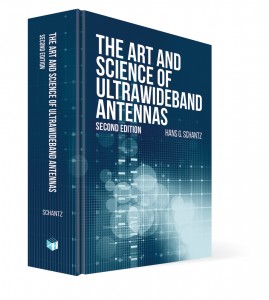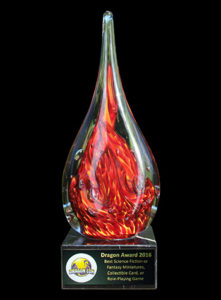 Noted antenna expert, Alan Boswell, was kind enough to share his thoughts on the second (revised) edition of The Art and Science of UWB Antennas. His review follows…
Noted antenna expert, Alan Boswell, was kind enough to share his thoughts on the second (revised) edition of The Art and Science of UWB Antennas. His review follows…
The first thing to say to someone familiar with antennas who picks up this book is that its subject matter is not as exotic as they might think. We are quickly told that ultrawideband antennas are those with a bandwidth of 20% of the center-frequency, or 500 MHz, whichever is the less. This definition includes many well known antennas such as the bicone, the inverted cone on a ground plane, the log-periodic antenna and even a half-wave dipole, provided it has been fattened up enough. Guglielmo Marconi, the founder of the radio industry, used cone and fan antennas in his early radio experimenting at Poldhu, Cornwall, in 1901, which are now recognized as ultrawideband antennas, and this fact is recorded in the book.
Short-wave radio users of the spectrum from 3 to 30 MHz can add to this list the rhombic antenna, which was shown in the 1980s to be capable of up to three octaves’ bandwidth, and the octave-bandwidth curtain arrays that were in widespread use all over the world for AM broadcasting at powers of 100 kW and upwards, and skywave radars producing a peak effective radiated power of up to 1010 Watts. None of these antennas was ever used to transmit wideband signals, but their wideband specifications were demanded by customers unwilling to retune the antennas on a band-change from 6 to 11 MHz, for example. They wanted only a pair of terminals into which the power could be driven, at any frequency within the range they paid for.
The need for time-domain analysis of wideband antennas is obvious as a supplement to the frequency-domain analyses that are commonly used. The use of dielectrics in antennas takes them outside the main focus of NEC, the moment-method code, which is given a mention in the book. Later codes based on finite-difference time-domain analysis allow more detailed analysis of these complex structures, and it is interesting that some of these include Fourier-transform code to enable frequency-domain radiation patters to be provided for those engineers demanding it as an alternative. The power of modern computers is such that these codes solve Maxwell’s equations directly, with boundary conditions given in the user-data, but it is still true that more analysis at the pre-coding stage always leads to less use of processing-time. This book show the way here.
That a book of upwards of 550 pages provides exhaustive coverage of its subject is only to be expected. But as the exposition progresses, this book poses many interesting questions of the sort that intelligent students always ask, and gives considered answers to them. Some of the questions are without a definite answer (as happens in electromagnetics) but if there are two answers, these are frequently given. The Poynting Vector continues to raise interesting discussions of interpretation, 130 years after its conception, and I was interested to read the views of Sir James Jeans, the distinguished cosmologist and physicist, on the subject, views which I happen to share.
I have no hesitation in recommending this book. You might not agree with everything in it, but you will be captivated and engrossed.
Alan Boswell, Great Baddow, Essex, UK
For additional reviews and more information (including how to order), see the UWB antenna book page.


One thought on “Alan Boswell Reviews The Art and Science of UWB Antennas”